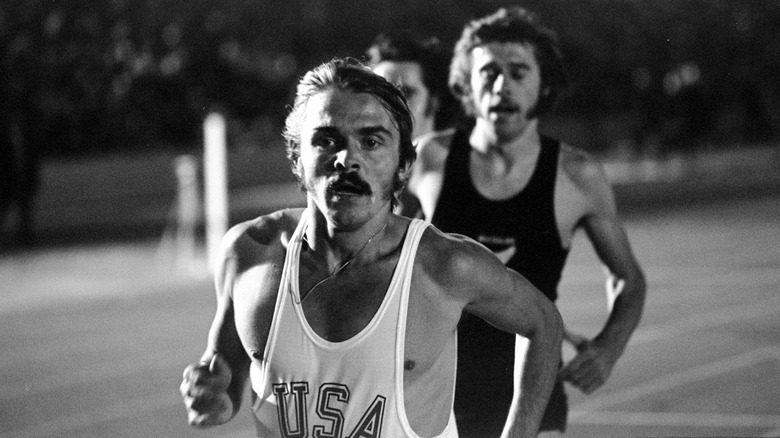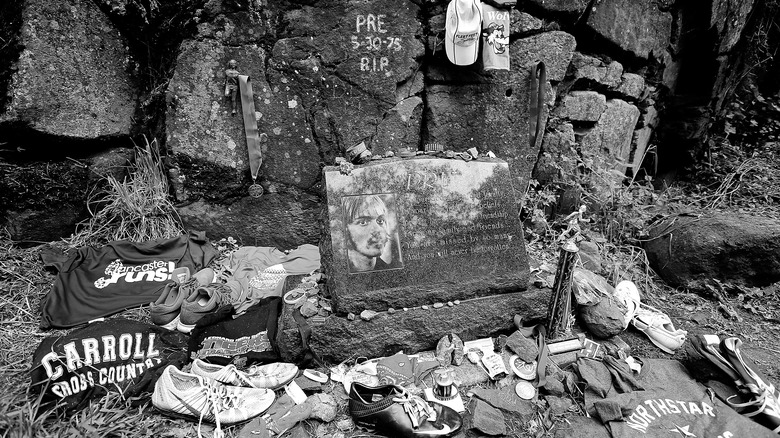Tragic Details Found In Olympian Steve Prefontaine's Autopsy
When Steve Prefontaine died in a car crash in Eugene, Oregon on May 30, 1975, it brought to a close one of the most explosive young careers in American sports. Just 24 years old at the time of his death, the athlete held seven American running records between 2,000 and 10,000 meters. During his career he broke 14 different records and ran nine sub-four-minute miles, a major achievement at the time. His three and six-mile records for Oregon, which he set in 1973, have yet to be broken.
But numbers alone don't tell the whole Prefontaine story, nor his lasting impact on the world of running. The Oregon native was a cultural phenomenon, with dashing good looks and charisma that brought him millions of fans and helped attract a raft of new devotees to American running, which in the 1970s was still in its infancy. Prefontaine's death was considered a sporting tragedy, one made more visceral in the collective consciousness after details of what happened that night were made public. His toxicology and autopsy reports found that he died of asphyxiation and had been drinking, giving more context to the Olympian's untimely death in context.
He died by asphyxiation
Steve Prefontaine didn't simply show up to compete. He was also instrumental in increasing the profile of American running by organizing professional track meets and inviting international runners. In fact, just before his death he was involved in an NCAA preparation track meet at Hayward Field in Eugene, Oregon. Prefontaine demonstrated his prowess on the track, winning a 5,000-meter race that would prove to be the last of his life. The post-race event at his friend Geoff Hollister's house included some of the biggest names in track and field, including Jon Anderson, who had won the Boston Marathon in 1973. Prefontaine left around midnight in his sports car to go home, dropping a friend off on the way.
He then continued on alone down Skyline Boulevard, a winding, difficult road where he lost control of his car and careered off the road. He was pronounced dead at the scene. The horror of the crash and Steve Prefontaine's tragic final moments are writ large in the autopsy report, which listed his cause of death as "traumatic asphyxiation," per The Seattle Times. His car, a butterscotch-colored MG, had flipped over in the accident and landed on his chest and stomach, starving him of oxygen.
Steve Prefontaine had been drinking
Some continue to believe that Steve Prefontaine simply died after losing control of his car. But that only tells part of the story. A blood test performed on the runner's remains indicated that he had been drinking alcohol before getting behind the wheel of his MG. Crucially, his level of consumption would certainly have impaired his driving ability and contributed to his vehicle veering off Skyline Boulevard that night.
Taken at 12:39 a.m., the sample revealed that Prefontaine's had a blood-alcohol level of 0.16%, well above the 1975 limit of 0.10% and double the 0.08% that is generally today's legal maximum. Though Prefontaine's friends have continued to assert that some obstacle must have caused him to crash that day, the findings of his autopsy remain. Sergeant Richard Loveall, the first responding officer to the scene, noted that while no alcohol was found in his car, there was a strong smell of alcohol — one that he remembered vividly. "He died because he consumed too much alcohol and drove," Loveall, who died in 2007, told The Register-Guard in 1985 on the 10th anniversary of the accident (via The Seattle Times). "That was the truth of the matter."


